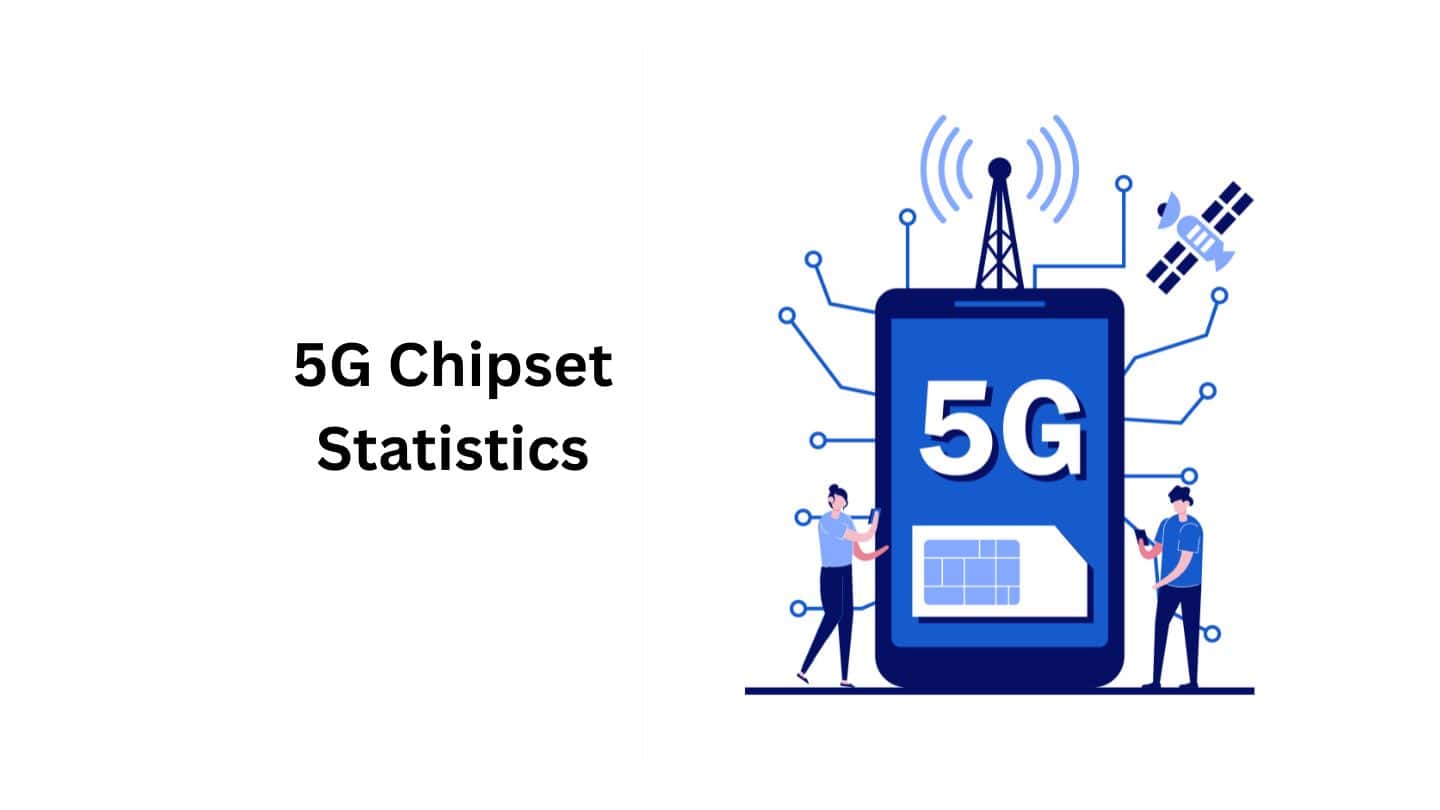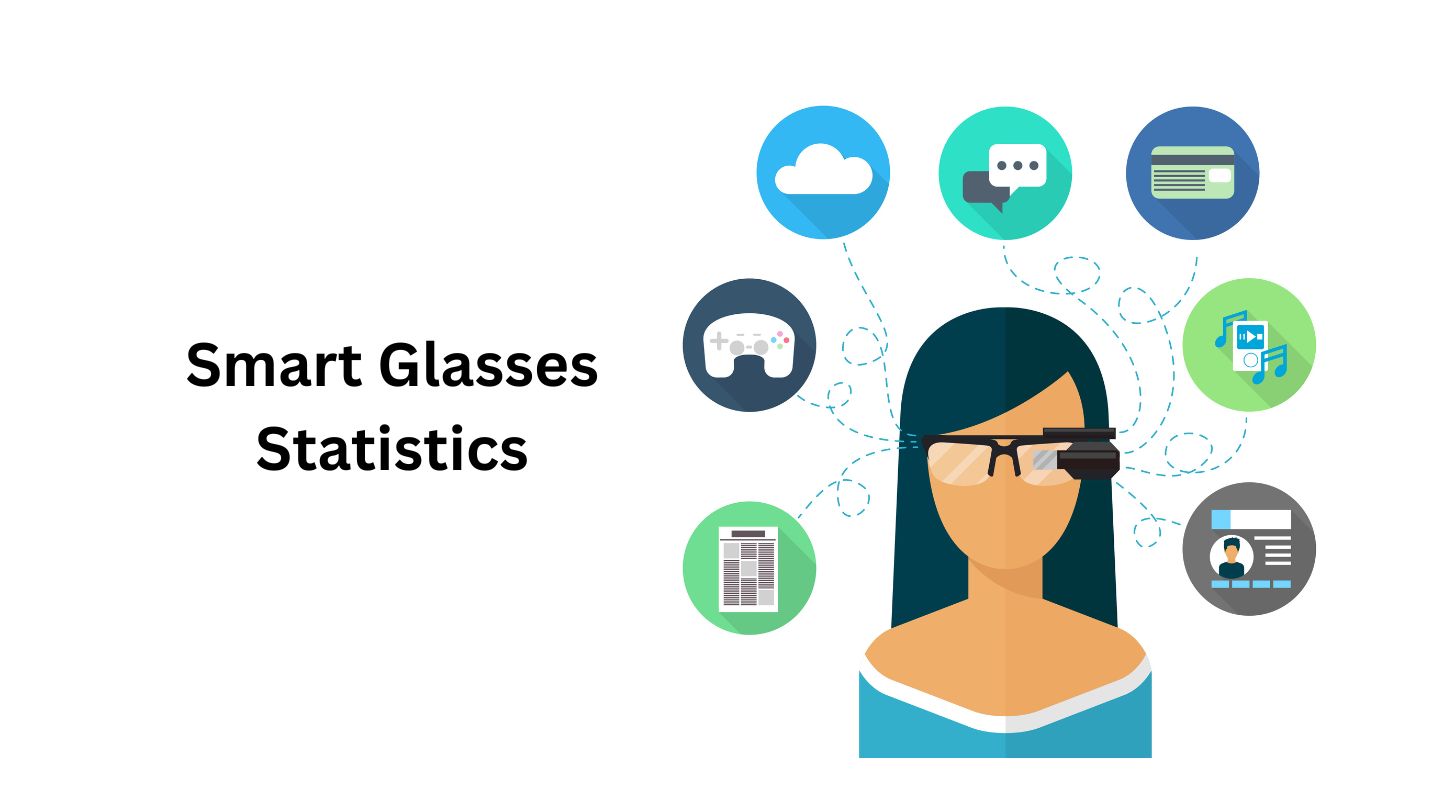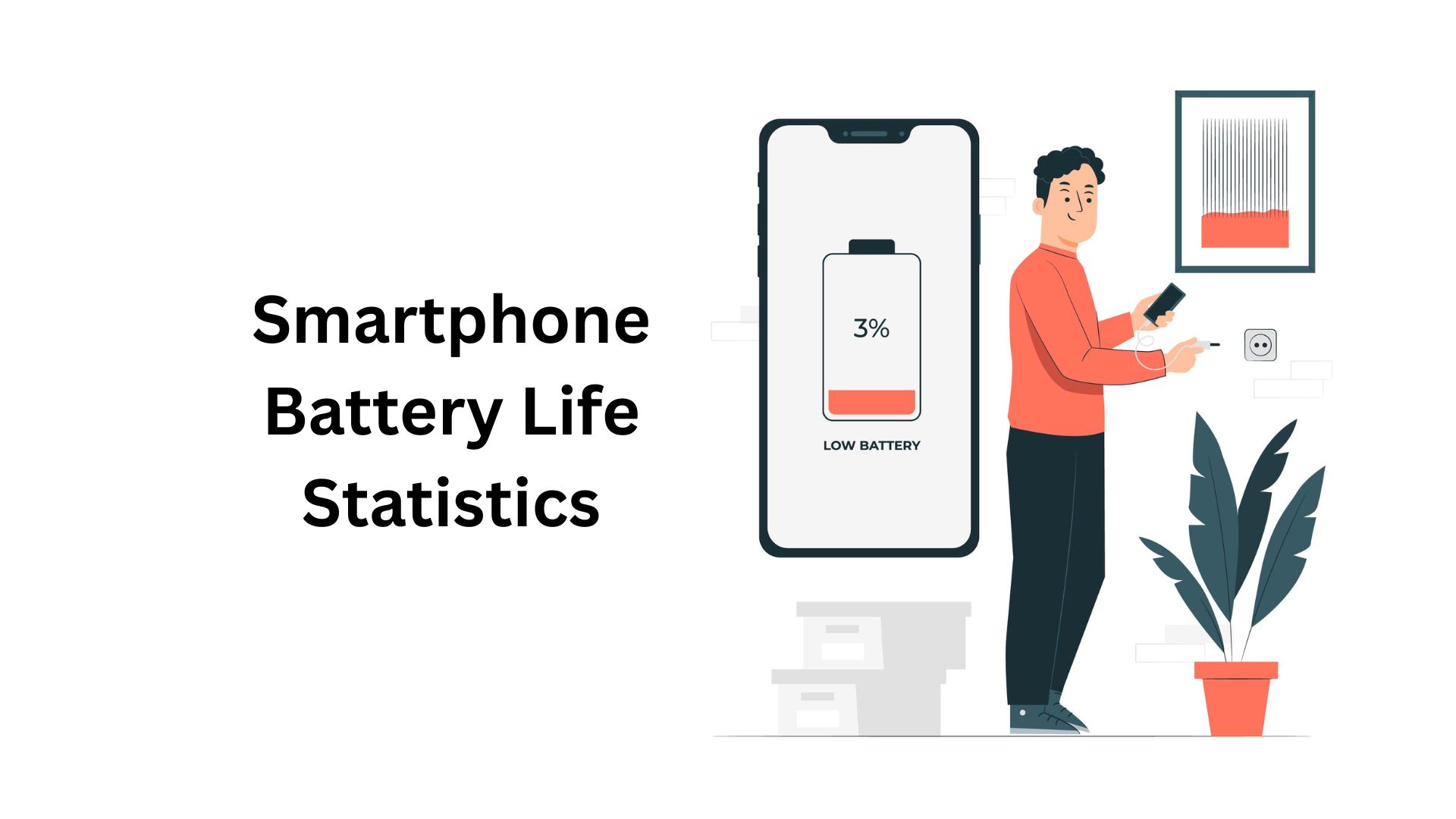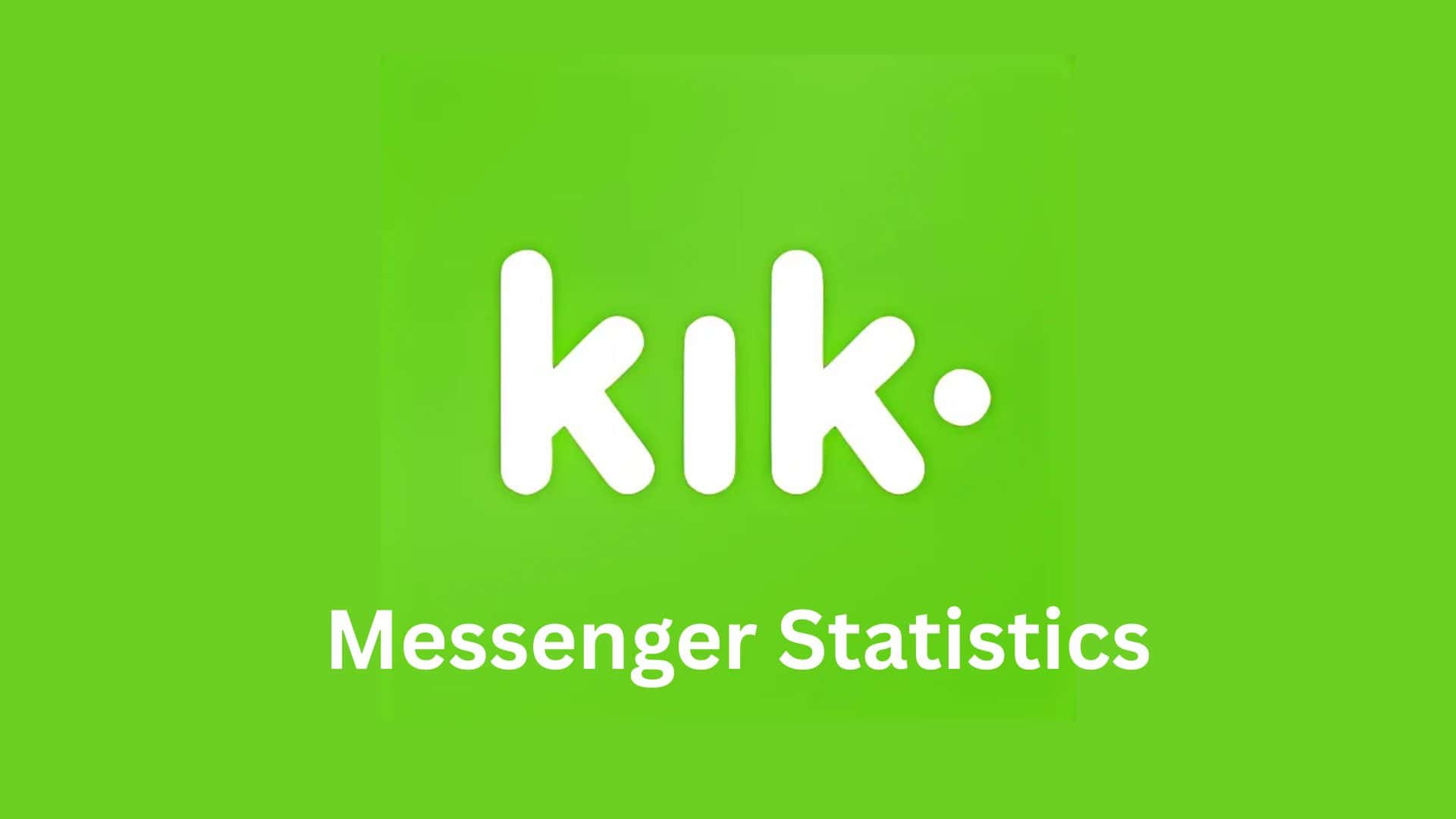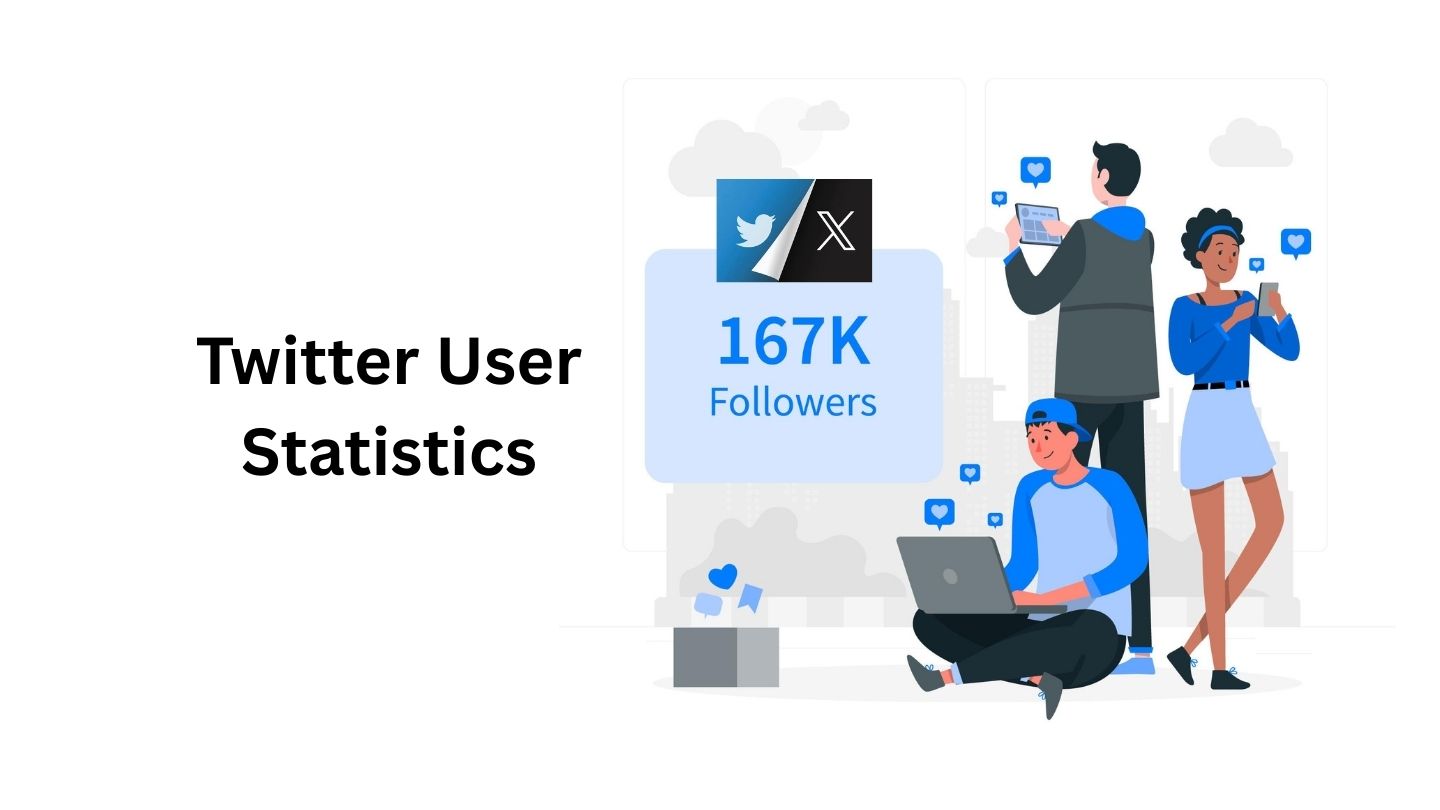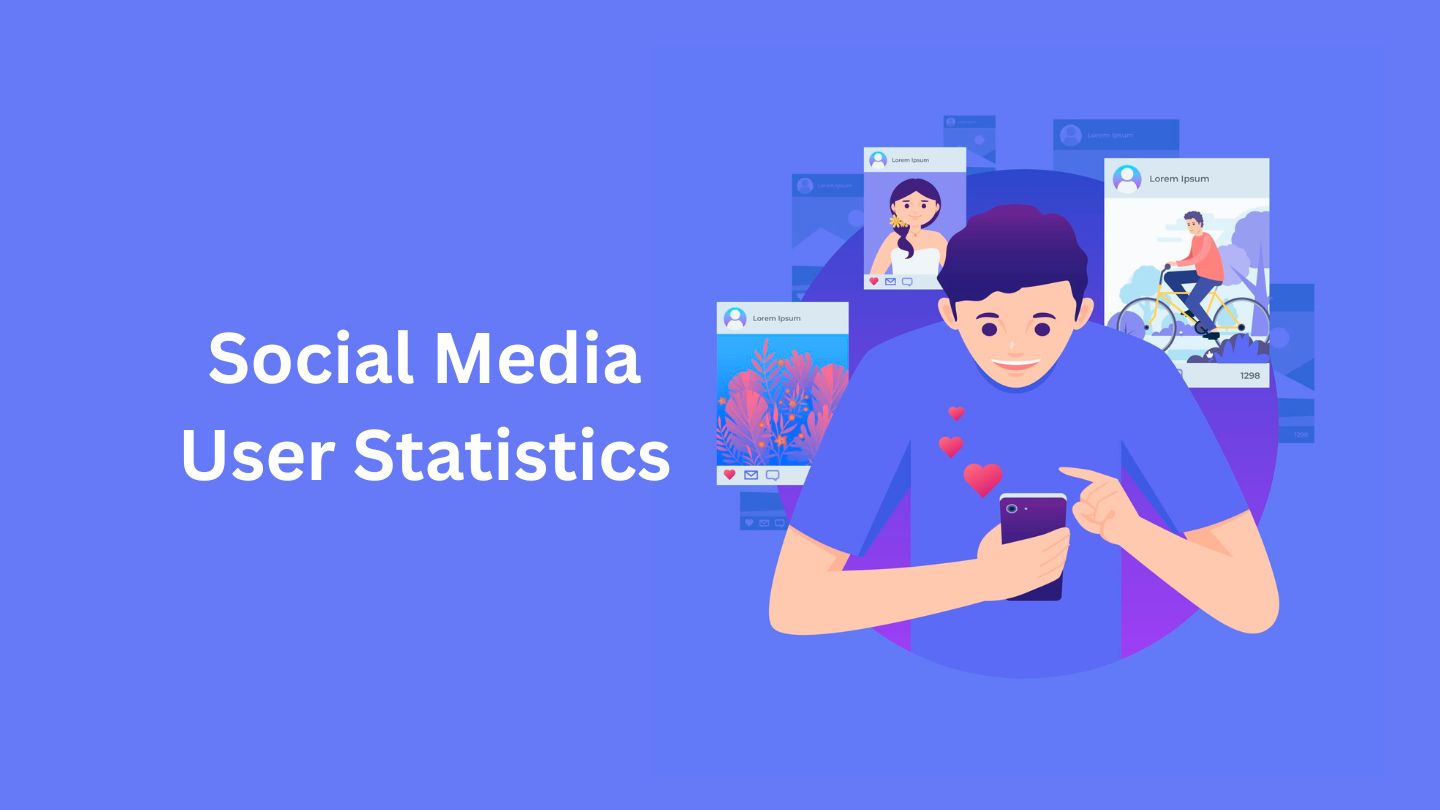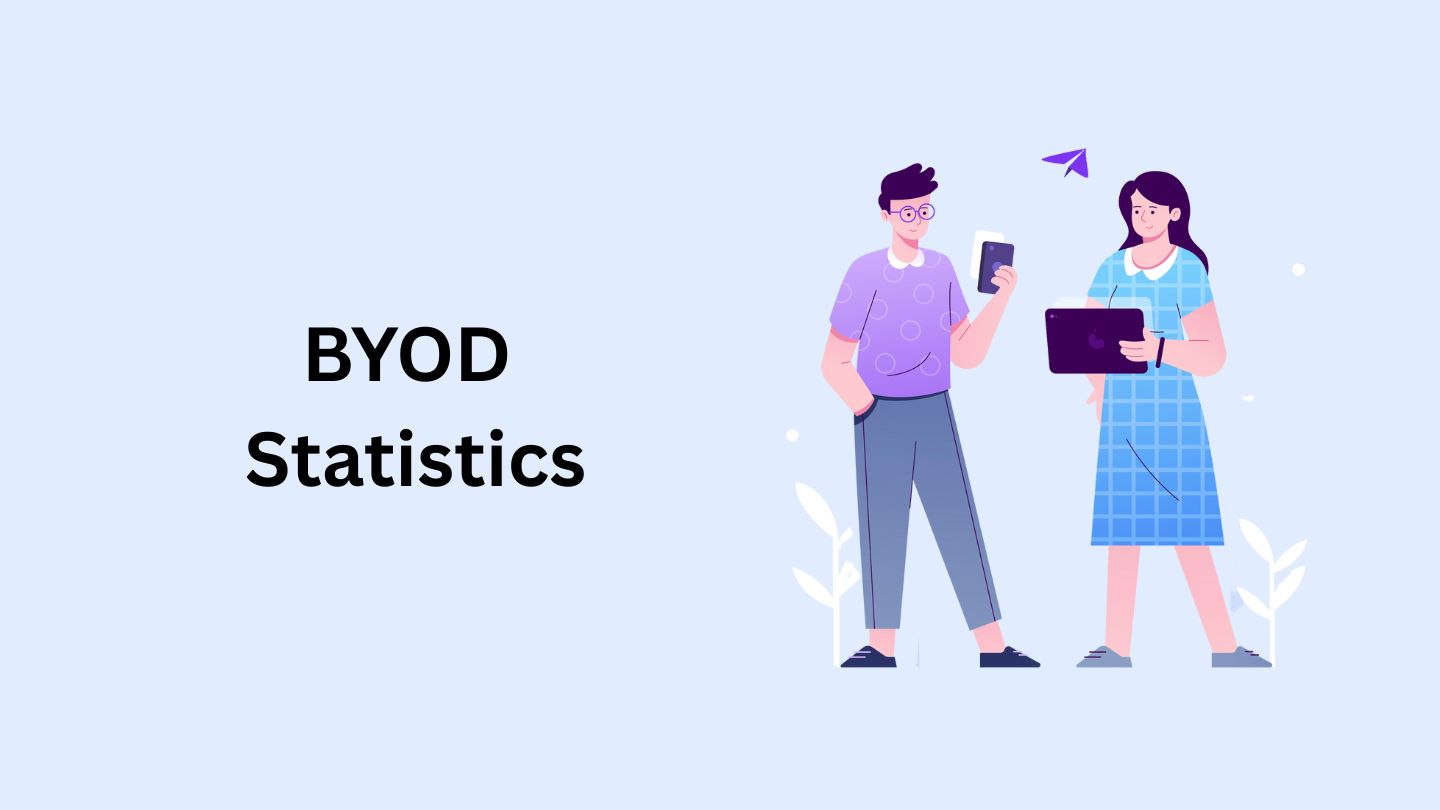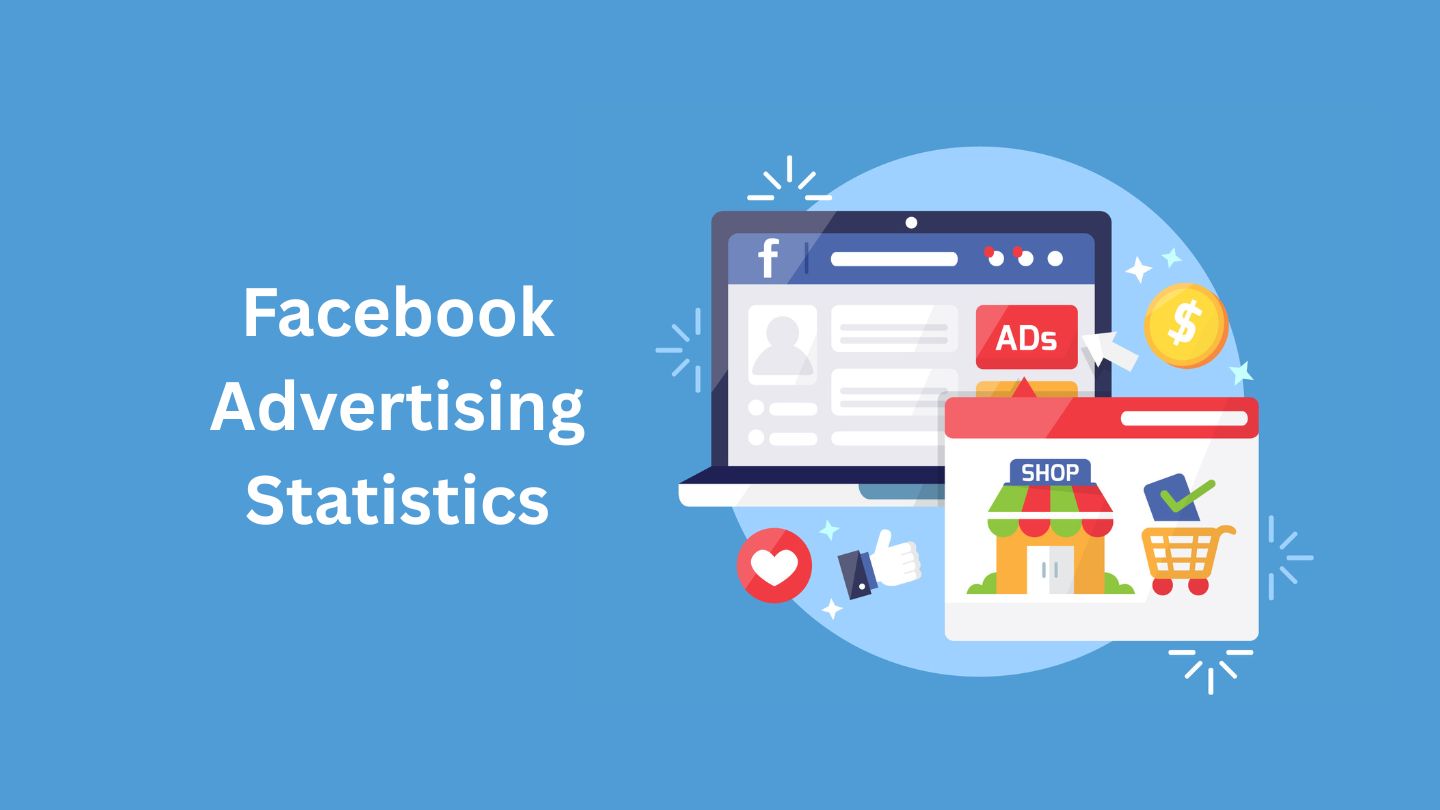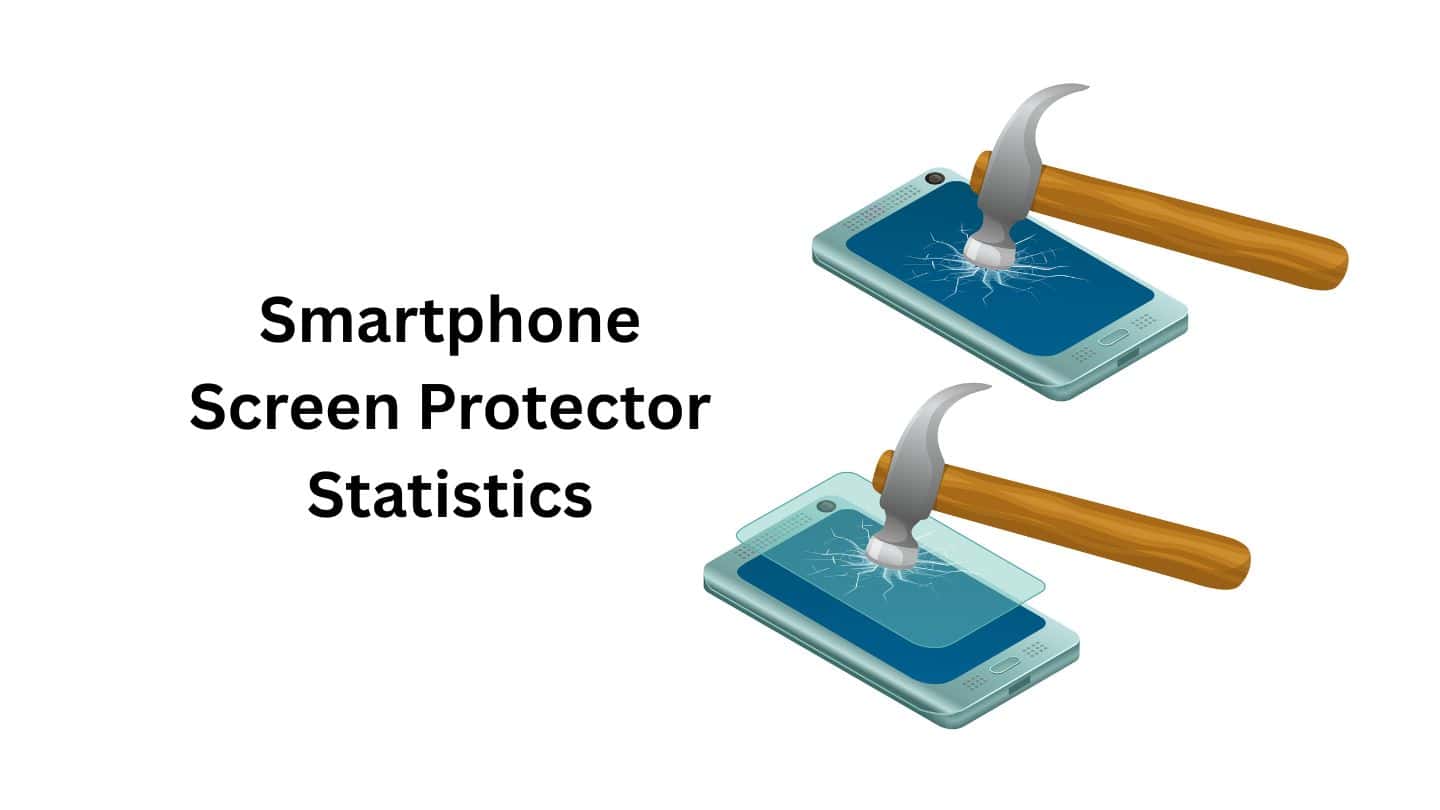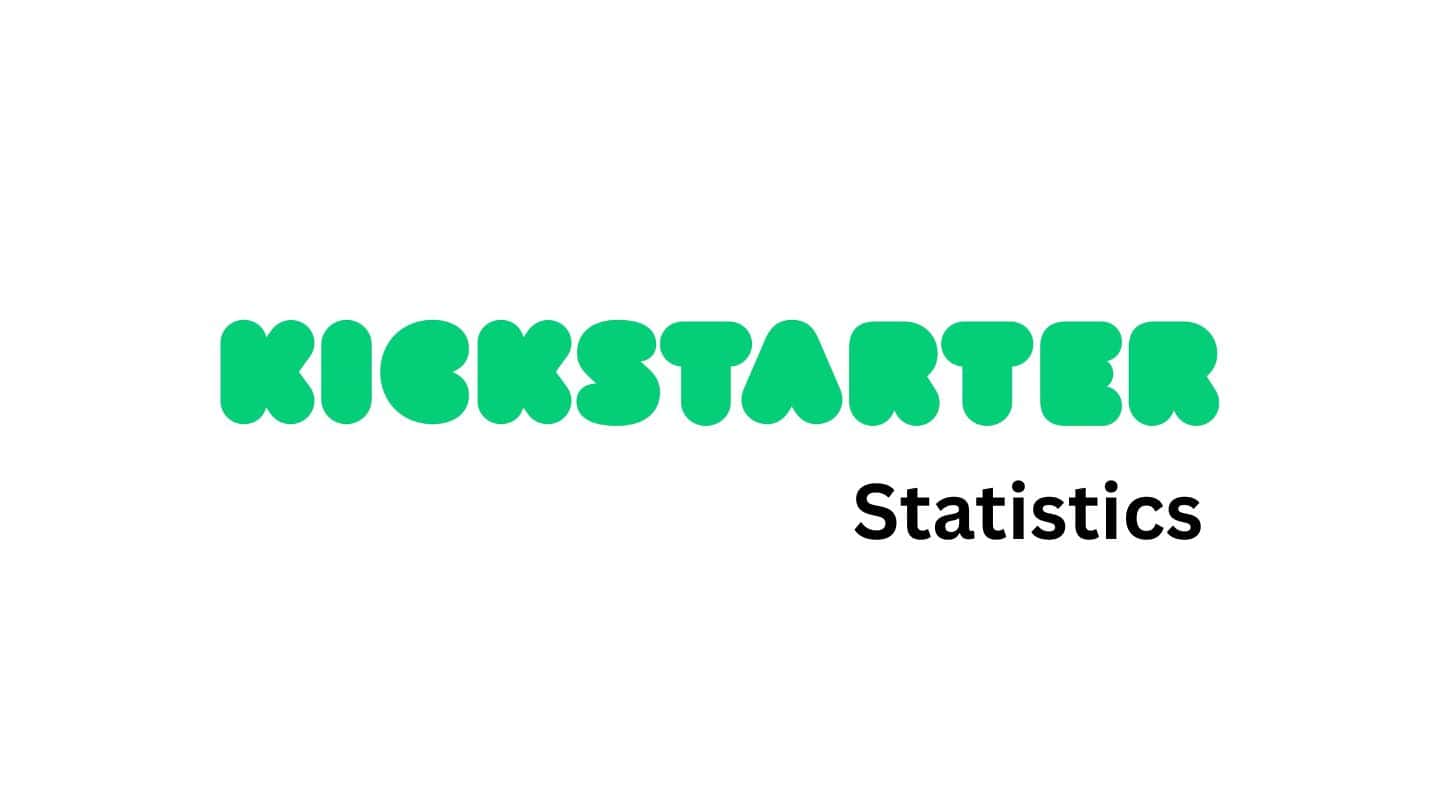Sleep Tracker Statistics By Market Size, Revenue, Usage, Monitoring Apps and Facts

Updated · Mar 04, 2025

TABLE OF CONTENTS
- Introduction
- Editor’s Choice
- Facts About Sleep Trackers
- General Sleep Tracker Statistics
- Top Benefits Of Sleep Tracker
- Sleep Tracker Statistics By Demographics
- Sleep Tracker Statistics By Most Downloaded
- By Highest Earning
- Reasons For Not Using Sleep Trackers
- Sleep Tracker Statistics By Monitoring Apps
- Sleep Tracking Apps Popularity Statistics By Country
- Global Sleep Aids Market Statistics By Country
- Sleep Tracker Is On The Rise
- Website Traffic Of Sleep Tracker Statistics
- Recent Developments
- The Best Sleep Trackers Of 2024
- Conclusion
Introduction
Sleep Trackers Statistics: Understanding and improving our sleep is crucial for our health and daily life. This is where sleep trackers come in. These devices, such as smartwatches or mattress mats, play a significant role in our lives, helping us collect data about our sleep patterns. They tell us how long we sleep, how often we wake up, and the quality of our rest. By analyzing this information, we can make informed decisions to improve our sleep and overall well-being.
This article explores sleep tracker statistics, showing how sleep habits differ among individuals. It also explains how tracking sleep can help identify sleep problems and improve health. With technology improving, sleep trackers are becoming more advanced, providing accurate and useful insights. Understanding sleep data can lead to better sleep routines and healthier lifestyles.
Editor’s Choice
- In 2023, 41.4% of users worldwide began tracking their sleep using sleep trackers.
- The Global Wearable Sleep Trackers Market is estimated to be valued at USD 2.22 billion in 2024, with Non-Wearable Sleep Trackers generating USD 309 million in revenue.
- Top Sleep Tracker Apps: ‘Sleep Cycle’ is expected to reach USD 1.36 million in revenue, while ‘SleepWatch’ is forecasted to earn USD 533,792 in 2024.
- In the United States, 37% of people used sleep-tracking technology in 2023, with 26% using smartphones or wearables for tracking.
- By 2024, one out of three Americans will use a sleep tracker device, and 78% find these devices beneficial.
- Reports show that 68% of people who use sleep trackers have already changed their lifestyle habits as of 2024.
- In 2023, 85% of American users believed their sleep trackers provided accurate results.
- On 28th November 2023, India was the top importer of sleep trackers with 53 shipments, followed by the Philippines (18 shipments) and Peru (14 shipments).
- On 5th April 2024, China led as the top exporter with 56 shipments, followed by the United States (43 shipments) and Vietnam (7 shipments).
- In February 2024, sleepcycle.com recorded 2.2 million website visits, marking a 17.44% decline, with a bounce rate of 43.33%.
- The COVID-19 pandemic caused sleep disruptions globally, with 32% of users reporting an increase in weekday sleep duration by over 20 minutes, while 17% slept less than usual during the pandemic’s acute phase.
- The rising incidence of sleep disorders like sleep apnea, insomnia, and narcolepsy is contributing to market growth.
You May Also Like To Read
- Fitbit Statistics
- Fitness Equipment Statistics
- Smartphone Addiction Statistics
- Wearable Devices Statistics
- Cameras Statistics
- Fitness Trackers Statistics
- Tablets Statistics
- Drones Statistics
- Foldable Smartphones Statistics
- Sleep Tracker Statistics
- Tablet Statistics
- Smart Home Statistics
- Dashboard Camera Statistics
Facts About Sleep Trackers
- Do you know? Once in a week, out of five, four people have claimed that they suffer from sleep-related problems.
- Sleep Tracker Statistics further state that sleep tracking devices perform even better than actigraphy.
- 61.7% of people cared about sleep in 2024 and planned to purchase sleep products.
- In the United States, 10-40% of adults have faced sleep difficulties and also highlighted their health issues.
- In smart wearables and smartwatches, the most widely tracked behavior is health-tracking, which includes activities and sleep.
- The common features of sleep trackers are that they measure sleep duration, sleep quality, sleep phases, environmental factors (bedroom temperature and amount of light inside a room), and lifestyle factors (amount of caffeine consumed and stress level).
- There are three types of tracker technology used: wristwatches, smartphone apps, and bedside sensors.
General Sleep Tracker Statistics
- As stated in Sleep Tracker Statistics, over one-third (35%) of Americans have used electronic sleep-tracking devices in recent years
- Moreover, 34.6% of users have claimed that sleep trackers enabled less stress.
- After using sleep trackers continuously over a longer period, 59% of users felt stressed when they forgot to track their sleep record.
- Among users, 77% found sleep trackers beneficial, and 68% modified their behavior based on the insights gained.
- Nearly 25% of online survey respondents in India and China reported using sleep monitoring apps in the past 12 months, while about 15% of U.S. adults did the same.
- In 2023, sleep monitoring apps generated USD 3.38 billion in revenue, and projections suggest that this figure will grow to USD 17.52 billion by 2033.
- Some individuals may experience increased anxiety from monitoring their sleep, potentially leading to a condition known as orthosomnia.
By Wearable Sleep Tracker
![]() (Reference: mordorintelligence.com)
(Reference: mordorintelligence.com)
- According to Mordor Intelligence, the market size of the global wearable sleep trackers in 2024 is estimated to amount to USD 2.22 billion and will cross USD 3.26 billion by the end of 2029.
- Besides, the annual growth rate of the industry will grow at a CAGR of 7.92% from 2024 to 2029.
By Non-Wearable Sleep Tracker
![]() (Source: ilu.valuates.com)
(Source: ilu.valuates.com)
- In 2023, the global market valuation of the Non-Wearable Sleep Tracker turned out to be USD 309 million.
- However, the market is predicted to approach USD 743 million in revenue by the end of 2030, with an annual growth of 13.2% CAGR from 2024 to 2030.
- Currently, the top manufacturer share of non-wearable sleep trackers is Apple (28.01%), ResMed (22.16%), Withings (6.86%), Simmons Bedding Company (5.84%), Sleepace (2.60%), Empit (0.55%), and other brands (33.98%).
Top Benefits Of Sleep Tracker
- According to a survey published by sleepjunkie.com in the United States, 75% of respondents claimed sleep trackers made them more aware of sleeping habits.
- 55.8% of people said that sleep trackers enable a better understanding of sleep problems.
- 44.9% of respondents felt refreshed after waking up every morning.
- Furthermore, other benefits reported by sleep tracker users include feeling healthier (42.9%), an increased energy level (39.3%), enhanced productivity (29%), and feeling optimistic about life (28.1%).
Sleep Tracker Statistics By Demographics
- As of 2023, in the U.S., 41% of millennials and 40.8% of parents have utilized sleep-tracking technology
- 40.8% and 38.7% share was captured by Parents and Women, respectively.
- Meanwhile, 35.8% of Men and 35.8% of Gen Xers have tracked their sleep.
- Other generations tracking sleep shares are Non-parents (33.5%) and Baby Boomers (22.8%).
By Education And Income
- Sleep Tracker Statistics claimed that, in the U.S., based on Education, college diploma sleep tracker users had a share of 40.1%, followed by high school diploma users with a share of 35.7%.
- 45.8% of American users of sleep trackers’ annual earnings were around USD 50,000 or more.
- Around 31.8% of users earn less than USD 50,000.
By Frequency Of Reviewing Tracking Data
- In 2023, Sleep Tracker Statistics stated that only 1.3% of users checked their trackers a few times per year to monthly to review sleep-related updates in the U.S.
- In addition, 9% of sleep tracker users checked a few times per month to weekly.
- On the other hand, 22.1% of users reviewed their sleep records once a week.
- Other users share by review frequency: 33% (2 to 3 times a week) and 34.6% (4 or more times a week).
By Methods
- The top methods shared for tracking sleep in the United States are wearable sleep devices (74.5%) and non-wearable sleep apps (25.5%).
- Meanwhile, the average amount spent on wearable sleep devices was USD 147, followed by a non-wearable sleep app (USD 40).
You May Also Like To Read
- Smart Video Doorbell Statistics
- Wireless Gaming Mouse Statistics
- Electric Kettle Statistics
- Leaf Blower Statistics
- Zero Turn Mower Statistics
- Android TV Box Statistics
- Video Doorbells
- 360 Camera Statistics
- Portable Power Bank Statistics
- Bose Corporation Statistics
- Smartphone Sales Statistics
- Portable Printer Statistics
Sleep Tracker Statistics By Most Downloaded
![]() (Source: af.imgix.net)
(Source: af.imgix.net)
- By Sleep Tracker Statistics, the most downloaded sleep tracker from the App Store and Google Play in 2023 was ShutEye, with 9.8 million new downloads, up by 51% from 2022.
- BetterSleep is the second-ranked sleep tracker, with approximately 8 million downloads, which has increased by 127% from last year.
- Furthermore, Pokémon Sleep accounted for 6.7 million downloads, followed by Sleep Cycle, which had 4.8 million downloads.
By Highest Earning
![]() (Source: af.imgix.net)
(Source: af.imgix.net)
- As of July 2023, nearly USD 26 million in net revenue was generated by Pokémon Sleep, known to be the highest sleep tracker earner.
- ShutEye TM captured the second position with USD 17 million in revenue, followed by Sleep Cycle (USD 16 million) and BetterSleep (USD 13 million).
Reasons For Not Using Sleep Trackers
- Based on Sleep Tracker Statistics, 43% of people in the United States claimed that sleep trackers cannot help them sleep better.
- 29.2% and 21.3% of American people said they are not interested in sleep trackers and that they are more expensive, respectively.
- Other reasons for not using sleep trackers by American people are privacy concerns (16.4%), doubt in data accuracy (15.2%), and no sleep-related problems (14.6%).
Sleep Tracker Statistics By Monitoring Apps
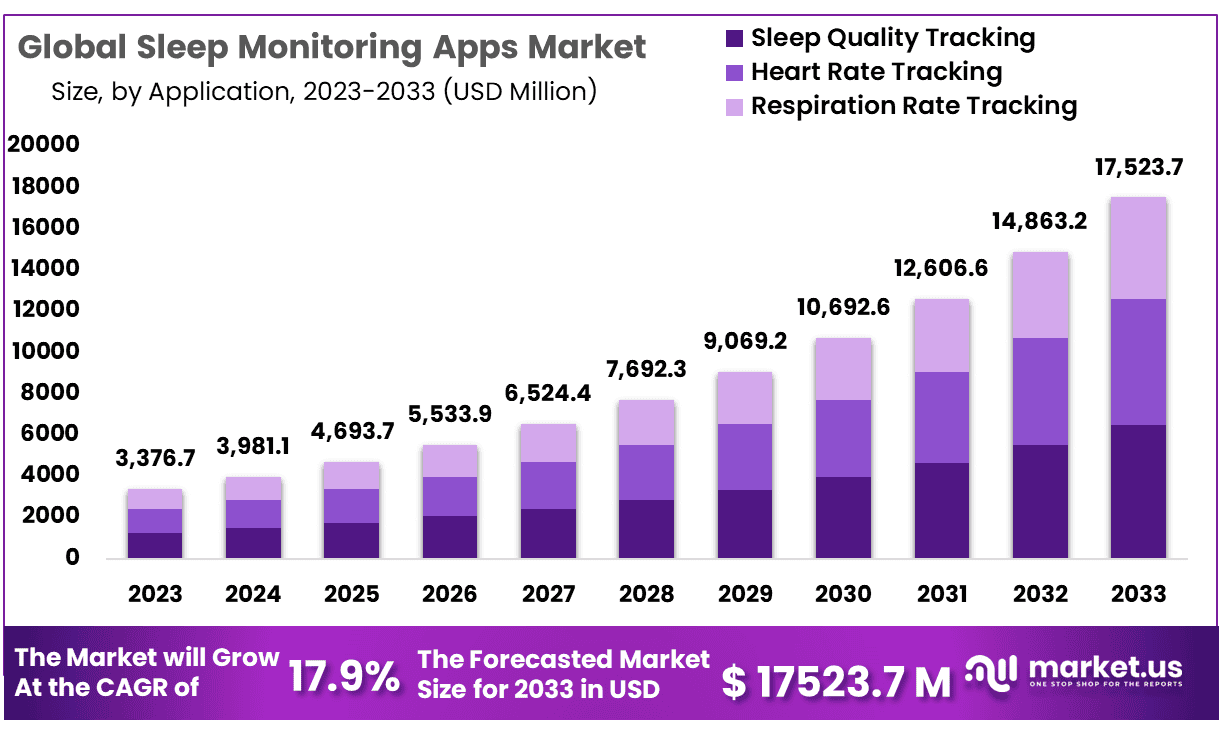
(Source: market.us)
- The Global Sleep Monitoring Apps Market size is expected to be worth around USD 17,523.7 million by 2033, from USD 3,376.7 million in 2023 and USD 3,981.1 million in 2024.
- The market is projected to grow at a CAGR of 17.9% during the forecast period from 2024 to 2033.
- Sleep Quality Tracking is a leading segment, commanding a substantial 37% market share.
- Android is the dominant operating system, holding an impressive 64% market share.
- The paid subscription model accounts for a significant 55% share of the market.
- North America captured 46.1% of the market share, generating USD 1,556.3 million in revenue in 2023.
Sleep Tracking Apps Popularity Statistics By Country
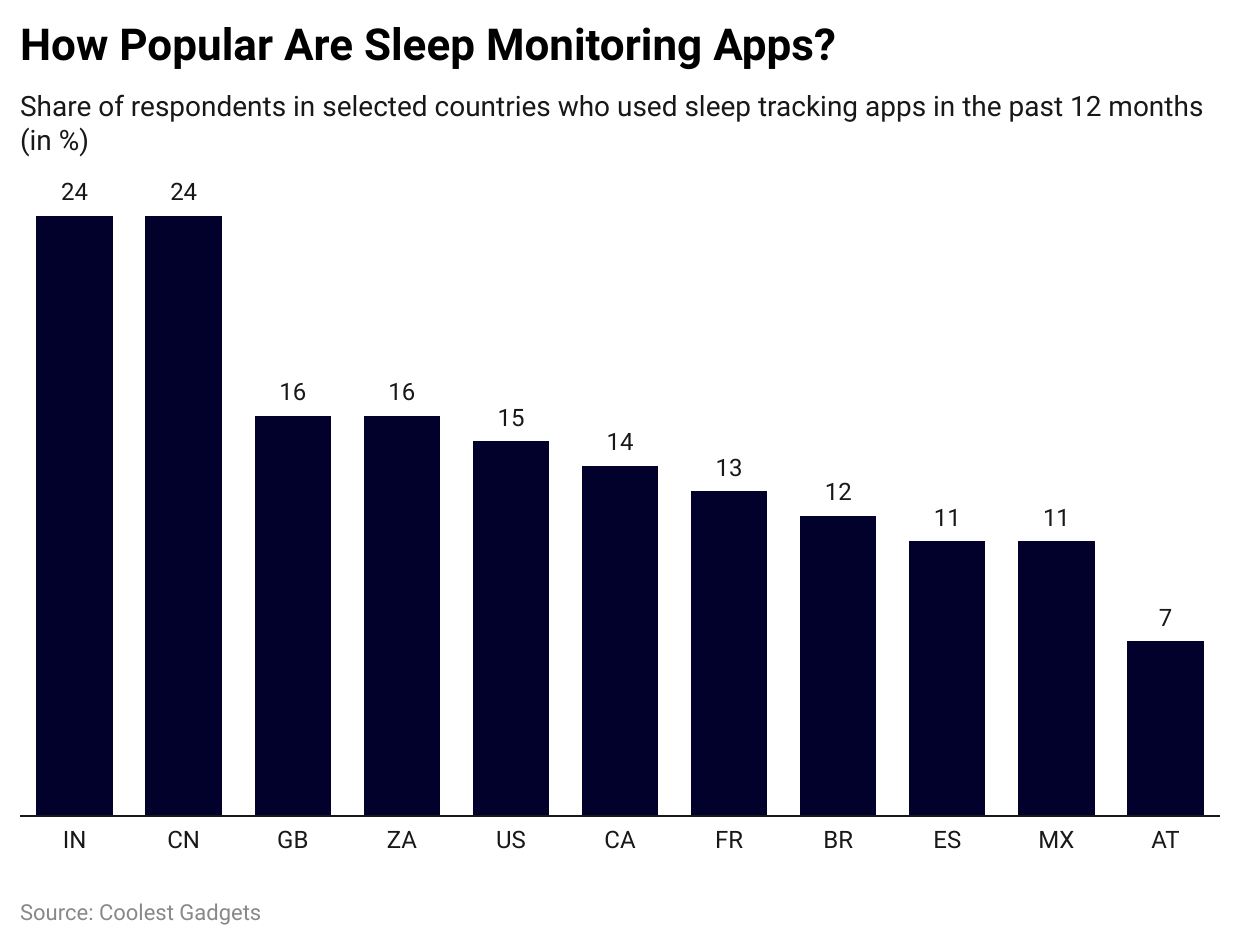 (Reference: statista.com)
(Reference: statista.com)
- According to a survey organized by Statista in the 1st quarter of 2023, in India and China, around 24% of respondents (each) have used sleep-tracking apps for monitoring sleep cycles and sleep time.
- Meanwhile, the share of people who use sleep monitoring apps in other countries is 16% (United Kingdom ), 16% (South Africa), 15% (the United Kingdom), 14% (Canada), 13% (France), 12% (Brazil), 11% (Spain), 11% (Mexico), and 7% (Austria).
Global Sleep Aids Market Statistics By Country
- As of 2024, the United States had the highest earnings, reaching USD 2,103 million. China followed in second place, generating USD 571.7 million.
- In Europe, Germany and France also play a big role, with revenues of USD 389.1 million and USD 362.8 million, respectively. India holds a strong position, with USD 289 million in revenue.
- Other European countries like Italy (USD 196.2 million), Spain (USD 183.5 million), and the United Kingdom (USD 128.5 million) also contribute significantly.
- Canada reports USD 108.1 million, followed closely by Russia with USD 105.3 million. Poland’s earnings stand at USD 92.72 million, followed by Indonesia’s at USD 77.93 million and Brazil’s at USD 74.7 million.
- South Korea brings in USD 58.83 million, while the Netherlands records USD 43.58 million, rounding off the list of key contributors.
Sleep Tracker Is On The Rise
![]() (Reference: sleepopolis.com)
(Reference: sleepopolis.com)
- Sleep Tracker Statistics also state that in 2023, 41.4% of sleep trackers globally will have started tracking their sleep.
- Whereas the sleep tracker usage share was 13.1% (2 to 3 years ago), followed by 1 to 2 years ago (25.8%) and more than three years ago (19.7%).
Website Traffic Of Sleep Tracker Statistics
By Country
![]() (Source: similarweb.com)
(Source: similarweb.com)
- As mentioned in Sleep Tracker Statistics, total traffic on sleepcycle.com in the United States had a 30.42% share, which has increased by 12.55% in total website visitors.
- Considering other countries total website traffic share are Sweden = 6.99% (+259.5%), United Kingdom = 5.39% (-52.24%), Germany = 3.85% (-36.42%), and Canada = 3.79% (5-5.72%)
- Other countries collectively made a visitor share of up to 49.57%.
By Demographics
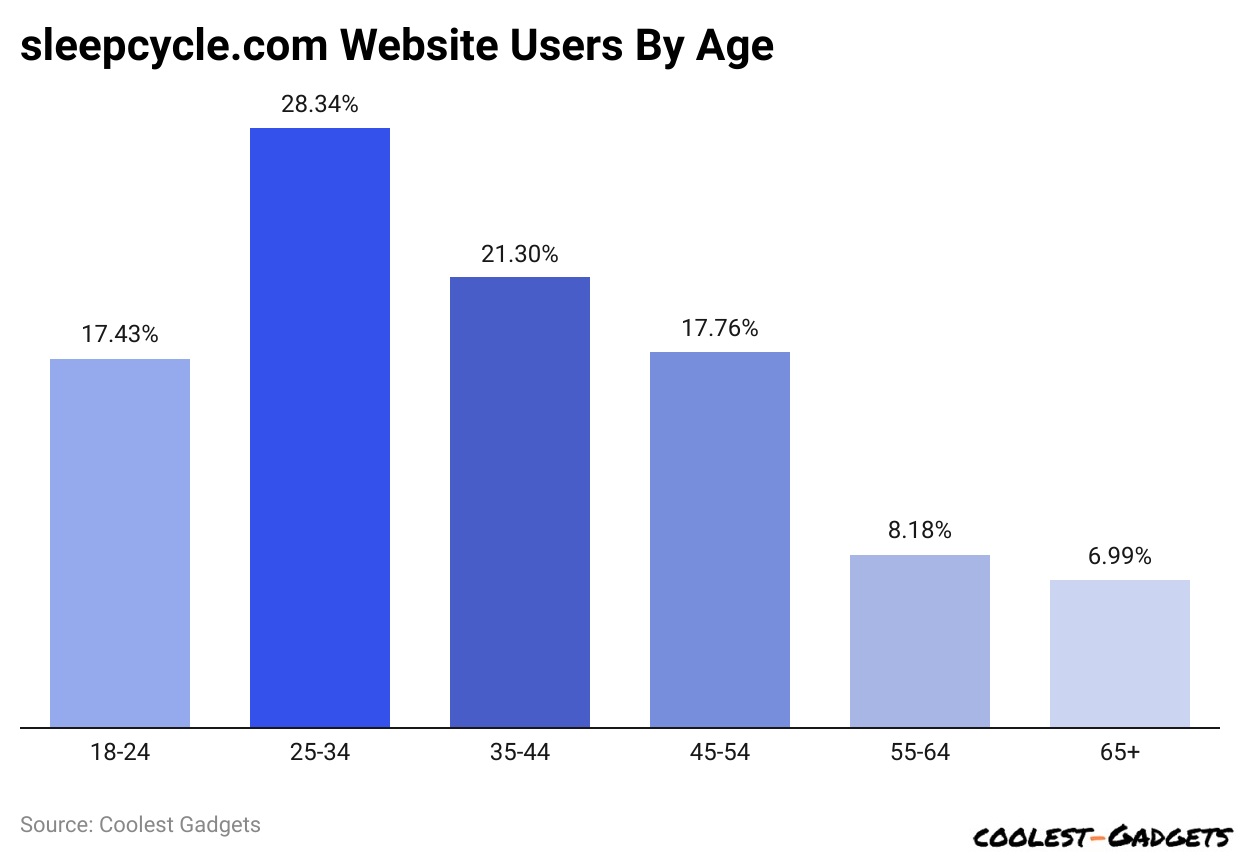 (Reference: similarweb.com)
(Reference: similarweb.com)
- The highest number of website users observed on sleepcycle.com is between 25 and 34 years old, resulting in a 28.34% share.
- Website users are aged from 35 to 44 years, making a website share of 21.3%
- 17.76% and 17.43% of website shares were generated by 45 to 54 years and 18 to 24 years, respectively.
- 8.18% of website users are between 55 to 64 years old.
- 65 years and above age group users contributed a share of 6.99%
- Male and female users of sleepcycle.com share were 54.84% and 45.16%, respectively.
By Traffic Source
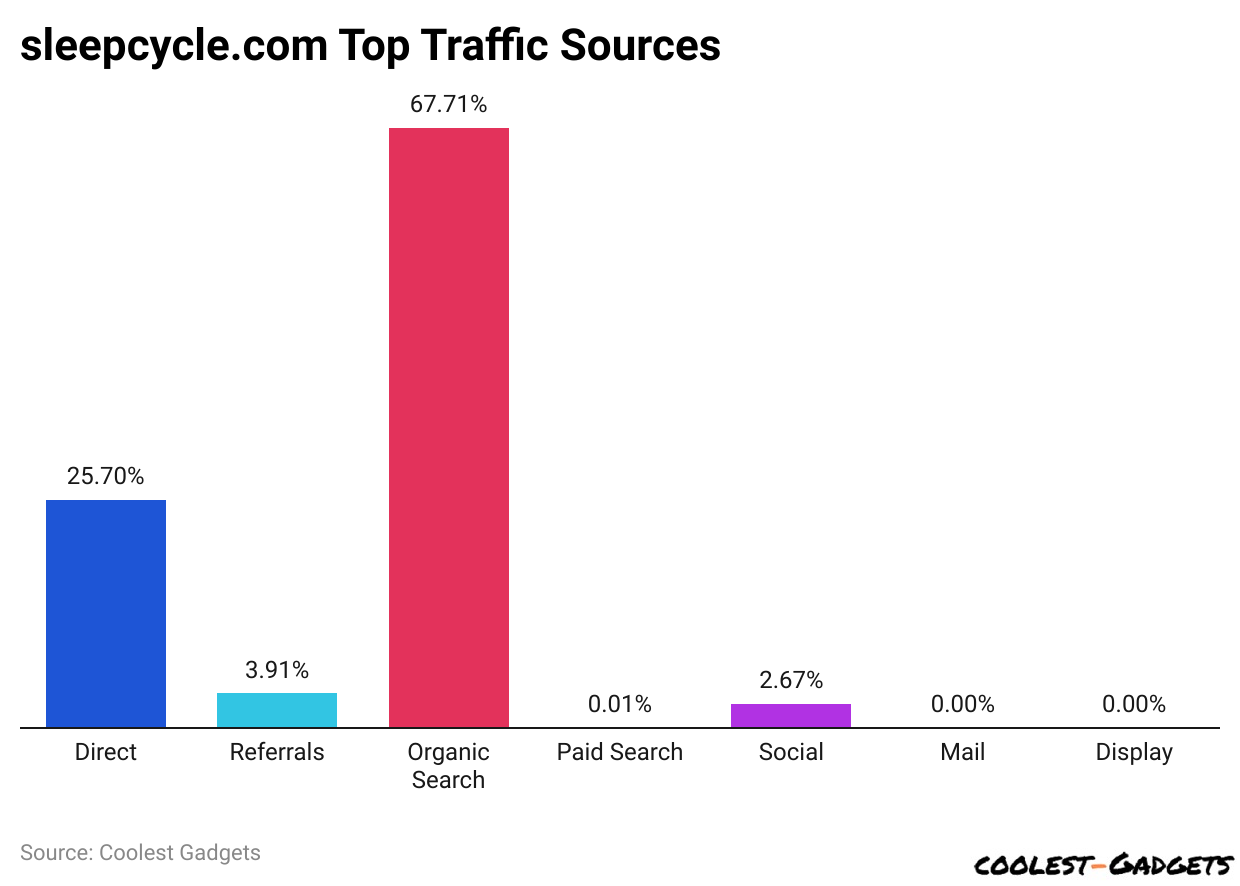 (Reference: similarweb.com)
(Reference: similarweb.com)
- Organic search accounted for the highest traffic rate toward sleepcycle.com, resulting in a 67.71% share in February 2024.
- 25.7% of the traffic share is accounted for by direct search, while 3.91% is from Referral.
- Furthermore, other traffic sources are social (2.67%) and paid (0.01%).
By Social Media Referral Rate
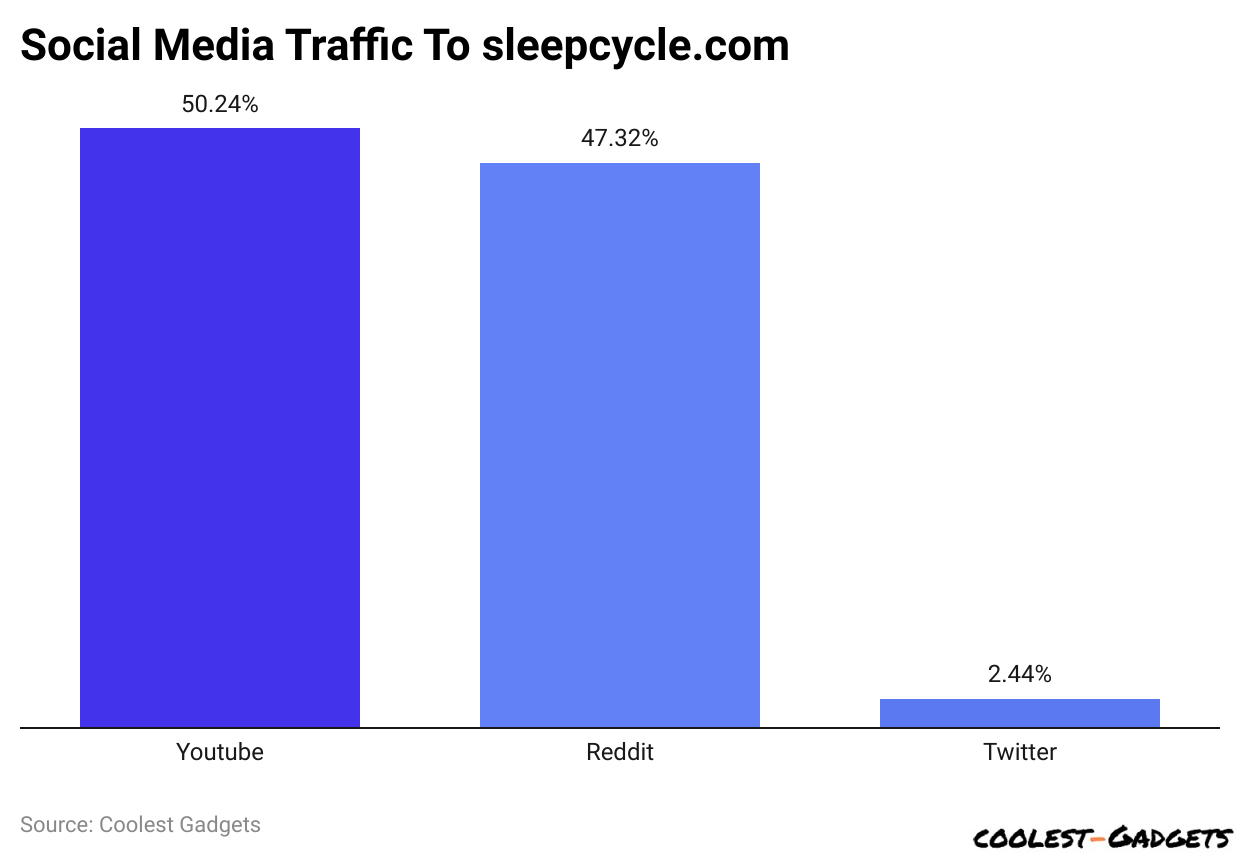 (Reference: similarweb.com)
(Reference: similarweb.com)
- On the sleepcycle.com website, YouTube recorded the highest social networking share, 50.24%.
- Reddit and Twitter contributed 47.32% and 2.44% of social traffic share, respectively.
Recent Developments
- Oura Ring Update (April 2024): ŌURA introduced Oura Labs, an in-app platform as part of the Oura Membership. It allows users to participate in research and development by testing new features and providing feedback, accelerating innovation in sleep-tracking technology.
- Huawei Band 9 Launch (April 2024): Huawei launched the Huawei Band 9, a fitness tracker that also monitors sleep. It features a 1.47-inch AMOLED panel and offers comprehensive sleep and sports tracking in a lightweight design.
- Infineon and Sleepiz Partnership (March 2023): Infineon, a German electronics company, partnered with Sleepiz, a Swiss digital health firm, to develop an at-home sleep monitoring device, enhancing the user-friendly sleep tracking market.
- Muse S Headband (2024): The Muse S Headband is an advanced sleep tracker that uses sensors to monitor brain activity, heart rate, and sleep stages. It pairs with an app for guided meditations, promoting better sleep habits.
- Withings Sleep (2024): The Withings Sleep device, a non-wearable sleep tracker, collects data on heart rate, breathing, and movement while being placed under the mattress. It generates daily reports and syncs with smart home devices.
The Best Sleep Trackers Of 2024
- Oura Ring (overall best): USD 300 to USD 450
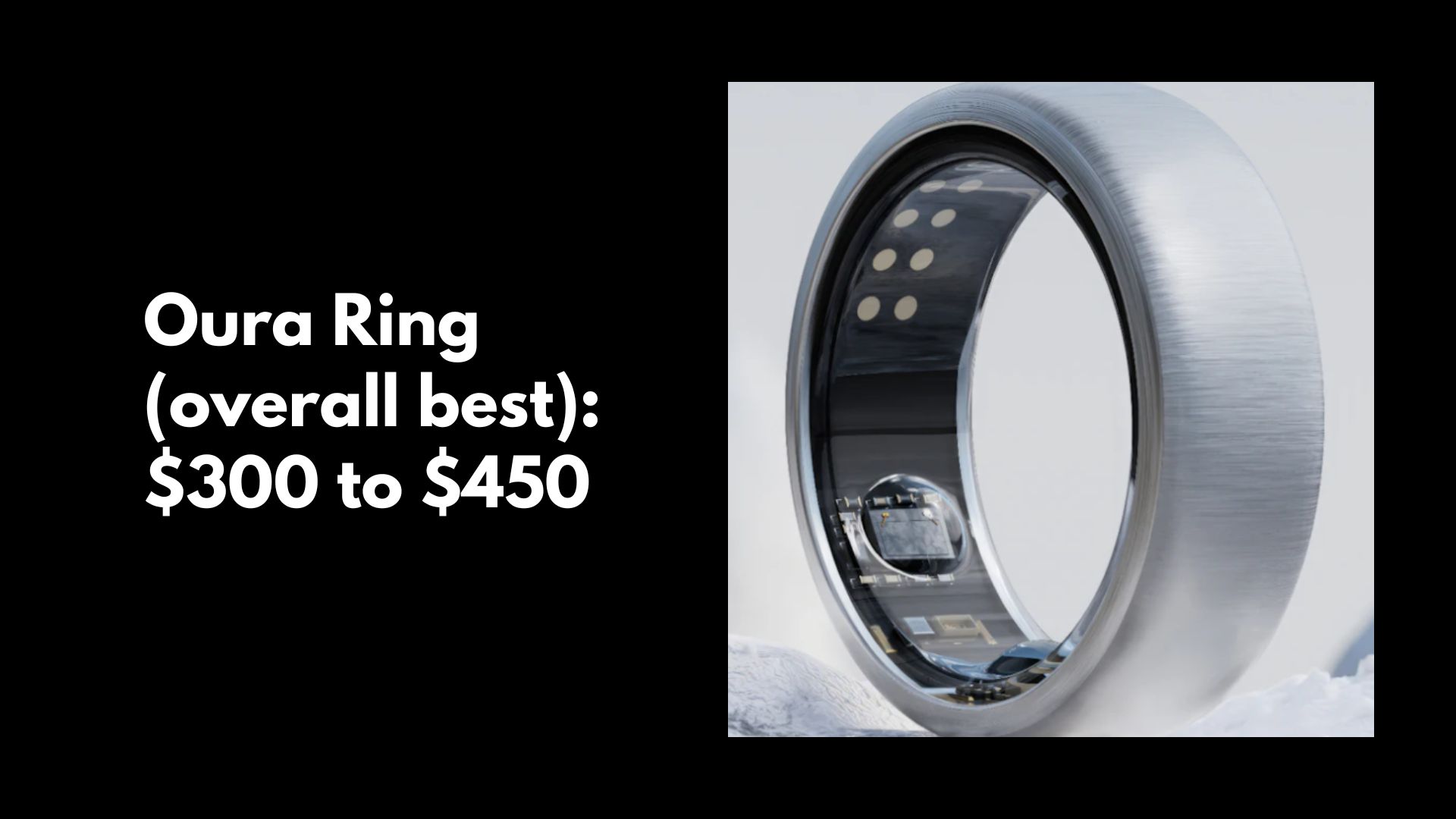 (Reference: ouraring.com)
(Reference: ouraring.com)
Tech specifications: material (durable titanium, PVD Coating, water resistance up to 100m/328 ft.), width (7.9 mm), thickness (2.5 mm), weight (4 to 6 gm), power (up to 7 days battery life, full charge in 20-80 minutes), connectivity (Bluetooth), sensors (green LEDs, Red LEDs, PPG sensors, skin temp. sensors, photodiodes, and 3D accelerometer).
Metrics measured: Sleep stages, daily sleep score, blood oxygen rate, potential early illness detection, activity and recovery, heart health, stress levels, and women’s health.
- Whoop 4.0 (best wristband): USD 239
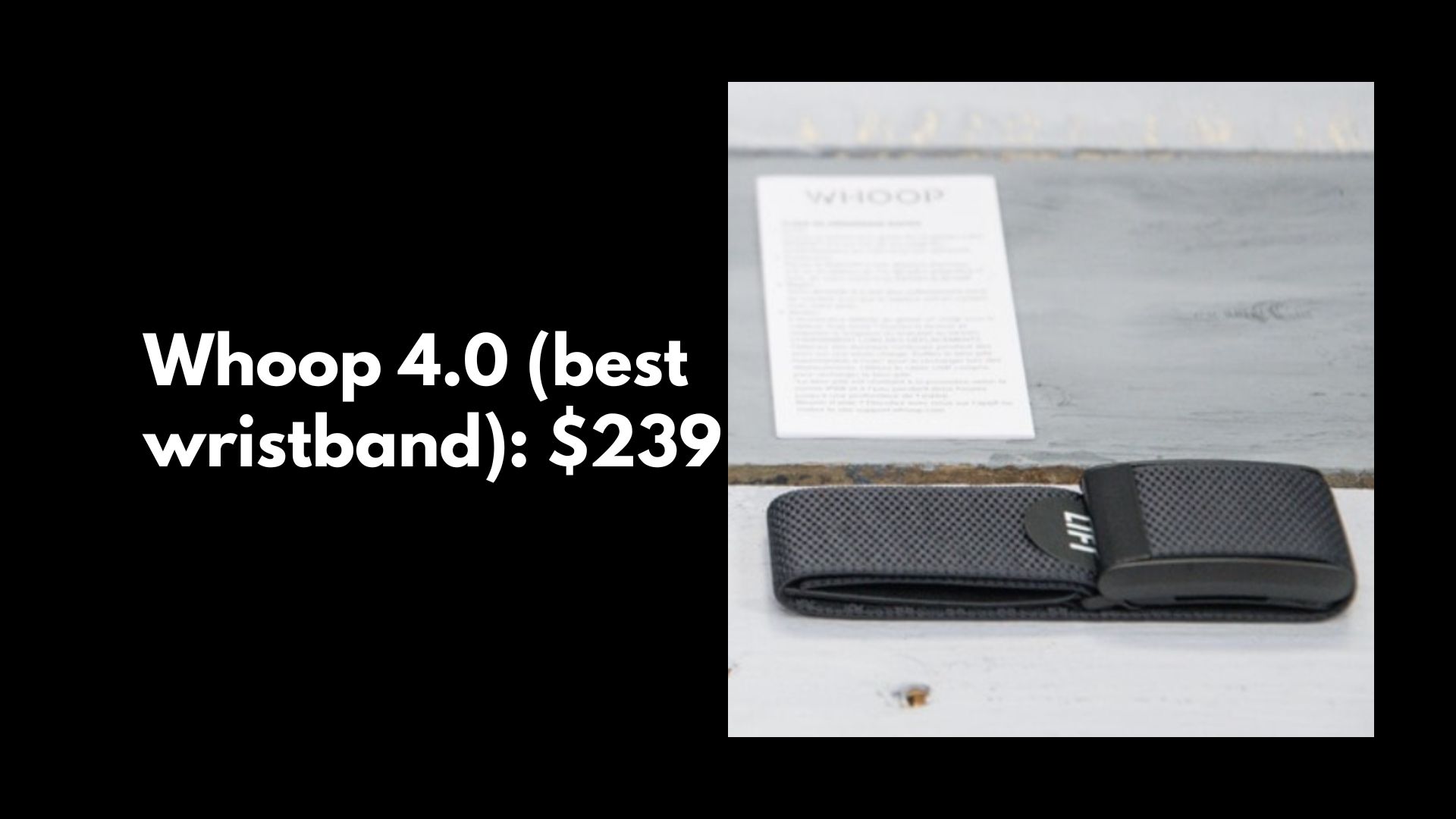 (Reference: media.dcrainmaker.com)
(Reference: media.dcrainmaker.com)
Metrics measured: sleep stages, sleep schedule, strain, recovery, stress, and battery (5 days).
- Apple Watch, series 8 and 9 (best smartwatch with sleep tracker): USD 399 to USD 1,149
![]() (Reference: bestbuy.com)
(Reference: bestbuy.com)
Metrics measured: Heart rate, wrist temperature sensing, menstrual cycle tracking, and battery life (more than 19 hours).
- Fitbit Inspire 3 (best for sleep and fitness): USD 99.95
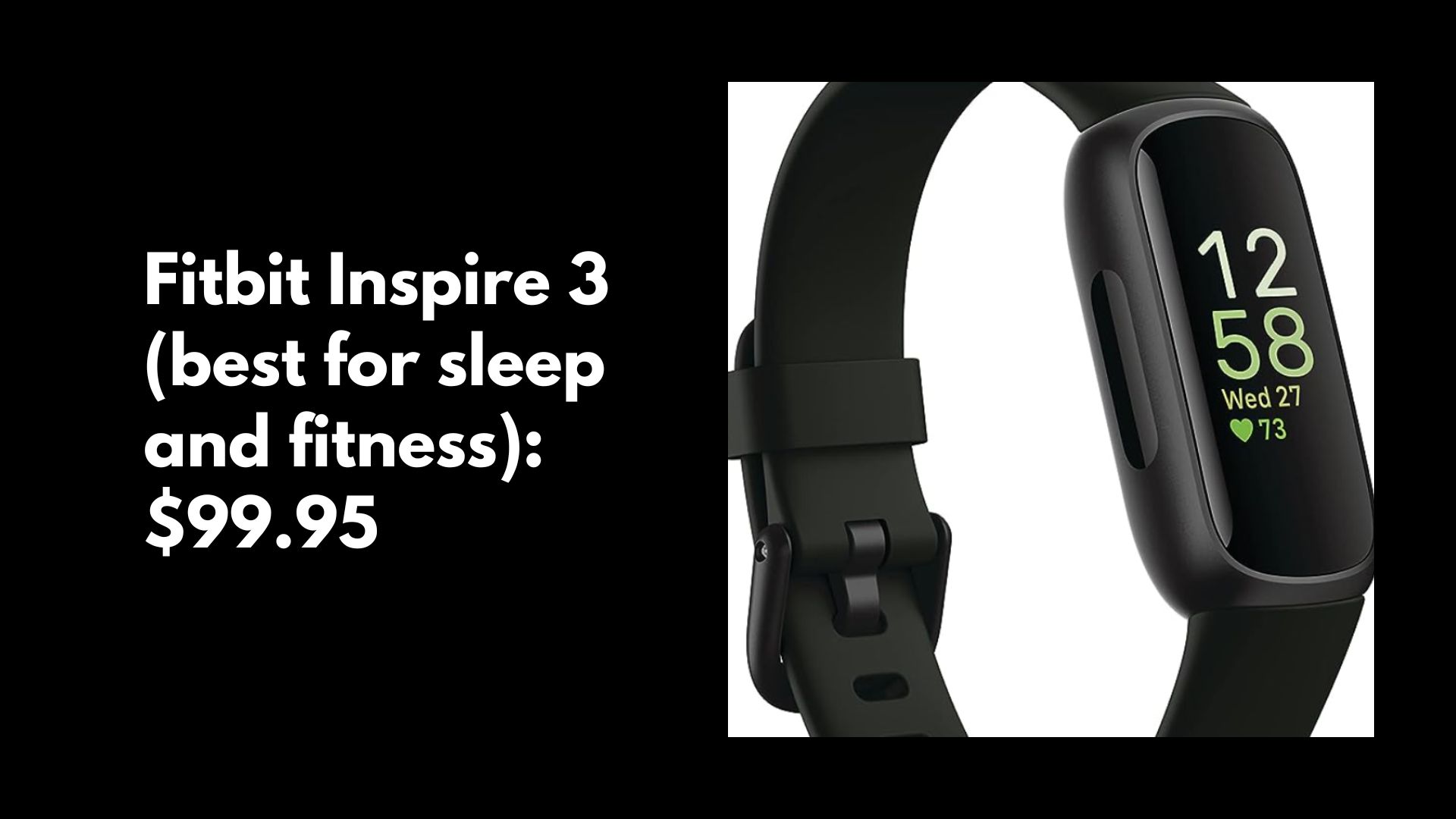 (Reference: amazon.com)
(Reference: amazon.com)
Metrics measured: Sleep stages, length of sleep, irregular heart rate, and battery life (above ten days)
- Withings sleep (best non-wearable sleep tracker): USD 130
![]() (Reference: withings.com)
(Reference: withings.com)
Metrics measured: Sleep duration, sleep cycles, sleep onset, and time to wake.
Conclusion
Sleep trackers help people understand their sleep habits and improve their rest. By collecting data on sleep patterns, these devices allow users to make better lifestyle choices. Many people have found them useful in adjusting their sleep schedules and reducing stress. However, some concerns exist about their accuracy and the anxiety they may cause. Despite this, the sleep tracker market continues to grow, showing increased interest in sleep health.
Using these devices wisely can lead to better sleep and overall well-being. As technology advances, sleep tracking will become even more effective in promoting healthier sleep routines.
Sources

Barry Elad is a tech enthusiast passionate about exploring various technology topics. He collects key statistics and facts to make tech easier to understand. Barry focuses on software and its benefits for everyday life. In his free time, he enjoys creating healthy recipes, practicing yoga, meditating, and walking in nature with his child. Barry's mission is to simplify complex tech information for everyone.


